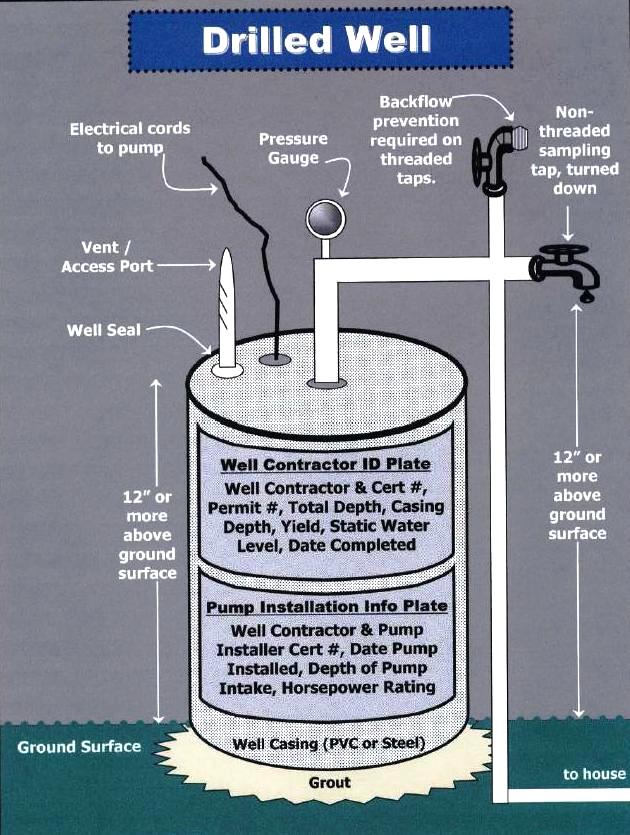
CONTACT:
Macon County Environmental Health
1830 Lakeside Drive, Franklin, NC 28734
Phone: (828) 349-2490
Phone: (828) 349-2489
Fax: (828) 349-4136
email
Office Hours:
8am -12pm 1pm - 5pm
Monday-Friday
Form Downloads
Request for Research
Links & Resources
Well & Well Water Information
North Carolina Environmental
Health Website
North Carolina Environmental
Health Administrative Rules
DIRECTIONS:
Turn onto Lake Emory Road off of 441 Business. Turn LEFT onto Lakeside Drive. Turn into Health Department Entrance; Drive around LEFT side of building
till you reach back corner entrance. Door is CODE ENFORCEMENT door.
This is the door you go in.
|
|
 Macon County Public Health Macon County Public Health
Environmental Health Services
Private Drinking Water Wells
The following documents and schedules are pertinent to Well construction, maintenance and
repair in Macon County. They are all available for download and printout via the free Adobe
Acrobat Reader. If you do not have
Acrobat Reader click here to download.
Well Head Inspection
The Certified Well Contractor, Pump Installer, or Property Owner shall notify the Health Department when
the well head installation is complete (pump installed, vent, hose bib, seal, well identification tag, and
pump indentification tag). An Environmental Health Specialist will then inspect the well head,
issue the Certificate of Completion and collect a
clearance water quality sample .
Water Quality Sampling
The local Health Department will collect a water quality sample from the well head no less than 24 hours
after the disinfecting agent has been purged from the well and within 30 days of the successful well head
completion inspection.
Water Sample Procedure:
Upon completion of construction or repair, a private drinking water well shall have the water tested within
30 days of issue of the Certificate of Completion by the Health Department. The Certified Well Contractor or
property owner shall assure that the well has been disinfected and that the disinfecting agent has been
subsequently purged from the well. The Health Department will then be notified the well is ready for water
quality sampling. An authorized agent from the Health Department will check the well water for residual
disinfecting agent using an approved test kit. As soon as it has been documented that the well water is
clear of disinfecting agent, the Health Department will collect a water sample.
It is the responsibility of the property owner to provide a source of power for the purpose of collecting
a water sample. Water samples will not be collected if there is no power source or if any residual disinfecting
agent is detected in the well. The well head shall be made easily accessible for the purpose of collecting a
water sample.
A $125.00 return visit fee will be assessed the property owner or well drilling contractor when Health
Department staff are unable to collect a water sample due to the presence of residual disinfecting agent,
inability to access the well head, or if a power source is not available.
Water samples can be collected from Monday thru Thursday, excluding Holidays. (Laboratory protocols and
analytical holding times limit the days on which a water quality sample may be collected.)
The Health Department will provide a copy of the water quality test results to the owner of the newly
constructed or repaired drinking water well. Water quality test results will be kept as a permanent part
of the public records of the Health Department.
Analyses:
Water samples will be tested for the presence of Total and Fecal Coliform. Water samples will also be
analyzed for Arsenic, Barium, Cadmium, Chromium, Copper, Fluoride, Lead, Iron, Magnesium, Manganese, Mercury,
Nitrate, Nitrite, Selenium, Silver, Sodium, Zinc and pH.
Abandoning Wells
The owner of a well must abandon a well within 30 days of a Notice to Abandon issued by the local Health
Department. Within 30 days of commencement of construction, the owner or Certified Well Drilling Contractor
must abandon a well that will not be placed into service. Abandoning of a well must be documented on North
Carolina State Form GW-30, Well Abandonment Form. The local Health Department must be given a minimum of
24 hours notice of all well abandonment activities.
Records
A signed Well Construction Report or Well Abandonment Form
shall be submitted to the Health Department and the State by the Certified Well Contractor completing the
construction, repair or abandonment of a private drinking water well. The well construction report must be
received by the Health Department within thirty (30) working days after completion of the well. The North
Carolina State Form GW-1a is acceptable and recommended as the Well Construction Report
and Form GW-30 is acceptable and recommended as the Well Abandonment Report.
|